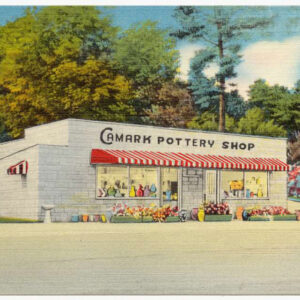calsfoundation@cals.org
Camark Pottery
Founded in 1926, Camden Art Tile and Pottery Company was the third and last producer of Art Pottery in Arkansas. By the end of its first year, its name had changed to Camark to include both the city of Camden (Ouachita County) and the state of Arkansas. Camark Pottery eventually became one of Camden’s best-known industries and was known nationwide.
Samuel Jacob “Jack” Carnes, a native of Zanesville, Ohio, and an engineer with knowledge of the pottery business, wished to access the regional pottery market, so he created the company with several Ohio associates, including businessmen and artists. They held a competition among twenty-five cities for its placement. Camden won the appointment in 1926.
At this time, Camden was booming. A 1921 oil boom in Smackover (Union County) brought economic wealth to the area. Camden benefited from an available work force and from the ability to ship products and materials along three railroads and on the then-navigable Ouachita River. The area was also home to a hydroelectric dam that supplied electricity for personal and industrial use. The Camden Chamber of Commerce donated a building and acreage to the company, which officially opened in May 1927.
John B. Lessell, an acclaimed potter in Newark, Ohio, produced the first pieces from Arkansas clays. He shipped these pieces from Newark to Arkansas and provided the beginning stock of the company. The clays came from the clay mines of neighboring towns of Lester (Ouachita County) and Chidester (Ouachita County) and was mixed by Carnes before shipping. Later in the history of the pottery, these clays were found to be inconsistent in quality and were mixed with clays from several neighboring states.
Lessell was to have headed the art department when the pottery was set up but died unexpectedly in Ohio on December 22, 1926. His widow, Jennie, and daughter, Billie, moved to Camden in February 1927 to head the beginning art department. Starting with two gas-fired kilns, twelve designs, and fifteen employees, the production of more pieces began in the summer of 1927. By the fall of the company’s first year, twenty-five workers used at least sixty-five molds and 100 designs to produce up to 500 pieces daily. The cost of these pieces ranged from fifty cents to twenty-five dollars each. The pieces were mainly lamp bases and vases. The early production of iridescent pottery and luster ware placed Camark Pottery firmly into the American Art Pottery movement and provided a sound financial foundation for the company. It was the first of three phases of Art Pottery production for the company.
With the pottery’s second year came a second phase of pottery production and the first of many personnel transitions for the company. The Lessells left, and Alfred P. Tetzschner, a native of Saxony, Germany, took charge and created new lines, including the Futuristic/Modernistic line. This line was influenced by the movement later known as Art Deco. These pieces were beautiful but costly to produce, with an average retail cost of thirteen dollars, and the line was discontinued in 1929. In addition to the Futuristic line, new mold designs and glaze manipulations were developed that continued throughout the life of the pottery. As was the practice among most Art Pottery manufacturers, Tetzschner was the artisan who created and finished original pieces that artistic employees subsequently copied.
Camark Pottery’s activities in 1929 were limited. Tetzschner left during that year, and the economic burdens posed by the Great Depression affected the pottery’s financial success. The company began to move toward less-costly production methods, as did several potteries nationwide. A third phase of pottery production emerged as the focus shifted from the artists and pottery decorators to interesting designs with new glaze manipulations. After 1930, molded pieces with glaze overlays and drips began to form the bulk of Camark Pottery’s production.
The market demands of low overhead and high output were met with a tool that was being used by many other potteries of that time. In 1936, a gas-fueled circular continuous tunnel kiln was installed; it required the labor of a single person and could produce 2,400 pieces in twenty hours. The cycle of production of 4,000 pieces had previously taken three to four weeks. Castware production then formed the majority of the company’s operation.
The repeated changes in personnel and economic pressures had begun to affect the company’s financial success. The production began to shift from innovative designs to nondescript flower vases and novelty ware. The colors changed to single solid colors and to matte finishes.
In 1939, Ernest Andrew Lechner began Camark’s first line of hand-painted pottery, meeting the public’s changing tastes in pottery. While this was a popular line, it was no longer Art Pottery because it lacked uniqueness and was produced in large quantities, thereby ending Camark’s position in the Art Pottery market but continuing in the production of what came to be known as industrial artware.
The height of pottery production occurred during World War II. Although the war imposed limitations on the availability of necessary raw materials of metals for the production of ceramics, a thriving market existed for non-metal gift items. Camark Pottery shipped pieces to New York companies such as Macy’s. During this peak, the pottery employed over one hundred people.
In the 1950s, Camark Pottery continued to mass-produce pottery in bright pastel colors. Its business continued well into the 1960s with the extremely popular Climbing Cats, salt and pepper shakers, and other novelty wares.
Camark always operated primarily as a wholesaler, shipping a great majority of its products out of state. In 1930, the first retail outlet opened on Highway 5, west of Little Rock (Pulaski County). The front of the store was in the shape of Arkansas. This was also the shape of the pottery mark. It was followed by many gift shops across the state and around the nation. Sightseeing tours of the pottery plant were popular throughout its history.
Several noted artists worked with Camark. Among them was Boris Trifonoff of Perm, Russia, a noted glazer and mold maker. Frank Long of Tyler, Texas, was the company’s only known handthrower.
Founder Jack Carnes died on September 25, 1958, in Hot Springs (Garland County). His wife continued to run the company until 1963 and sold the pottery a couple of years later. In 1965, the company was incorporated. Internal problems and decreasing profits eventually caused production to cease. The remaining stock pieces were sold until the 1980s through the retail store at the pottery until it closed its doors in December 1982. Camark Pottery, Inc., owns the property to this day.
At one time, Camark Pottery was the best-known industry in Camden. This viable pottery outlived many of its predecessors. Pieces of Camark pottery have remained very collectible and can be found in museums. Camark provided a lasting contribution to the history of decorative arts and to the history of Art Pottery in Arkansas.
For additional information:
Arkansas Art Pottery. http://www.arkansasartpottery.com/index.html (accessed August 31, 2020).
Gifford, David Edwin. “The Art of Camark.” Ouachita County Historical Quarterly 29 (Winter 1997): 15–31.
———. Collector’s Guide to Camark Pottery. 2 vols. Paducah, KY: Collector Books, 1997, 1999.
Storey, Cecilia. “Lustrous Past.” Arkansas Democrat-Gazette, May 30, 2010, pp. 1E, 6E.
Dixie Covington Howard
Maumelle, Arkansas
Staff of the CALS Encyclopedia of Arkansas
 Camark Postcard
Camark Postcard  Camark Pottery
Camark Pottery  Jack Carnes
Jack Carnes 




Comments
No comments on this entry yet.